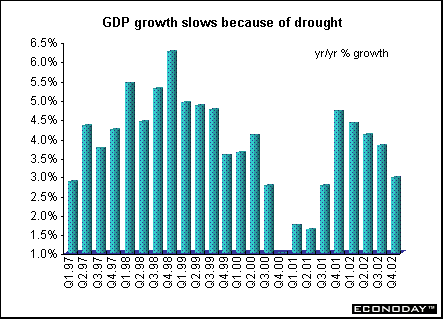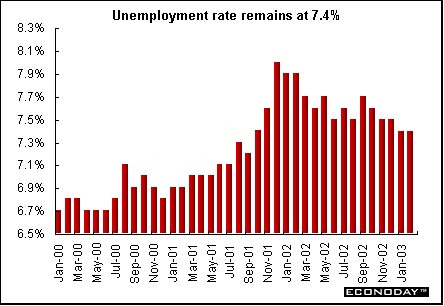
Indicator scoreboard
EMU - January seasonally adjusted unemployment rate rose to 8.6 percent from 8.5 percent in December. The January rate is the highest since March 2000 (also 8.6 percent) and was up from a rate of 8.1 percent in January 2002. Spain continued to show the highest unemployment rate followed by France, Germany and Belgium. Luxembourg showed the lowest unemployment rate followed by Austria, Ireland and Portugal.

February Reuters PMI manufacturing index rose to 50.1 from 49.3 in January. Growth in output and new orders picked up during the month. A reading of 50 is the break-even point between growth and contraction.

February Reuters PMI services index fell to 48.9 from 50 in the prior month. An index reading above 50 signals that activity is expanding, a reading below 50 that it is contracting. The lower the index is below 50, the faster the decline. Service sector growth has been slowing since November. Germany remained the weak spot, as sector activity contracted for a seventh straight month and at the fastest rate in the five-and-a-half-year history of the survey. In France, by contrast, activity expanded for the 15th straight month but at the slowest rate in four months. Italy's sector activity also expanded for the 15th-straight month but at the slowest pace since October.
January producer prices (excluding construction) rose 0.8 percent thanks to a jump in energy prices. Prices were up 2 percent when compared with last year. This was the fourth straight positive figure following a year of negative readings. Energy goods prices soared 2.8 percent and 6.1 percent on the year. Excluding energy products, PPI rose 0.3 percent and were unchanged on the year. Other than energy all PPI subcategories showed moderate increases.

December real workday and seasonally adjusted retail sales plunged 1.1 percent and 1.9 percent when compared with last year. Most retail trade categories fell on the month, including books, newspapers and other publication sales in specialized stores, household goods, food, drinks and tobacco as well as pharmaceutical and medical goods.

Fourth quarter real gross domestic product crept up by 0.2 percent and 1.3 percent when compared with the fourth quarter of 2001. For the full year 2002, GDP was 0.8 percent higher than 2001. The quarterly rise was due in large part to strong gains in private and government consumption. Investment spending fell. Exports were flat on the quarter, down from a third quarter gain of 2.1 percent as weak foreign markets and the stronger euro exchange rate weighed. Imports, on the other hand, continued to grow, likely helped by stronger domestic demand.

Germany - January real seasonally adjusted retail sales excluding auto and gasoline station sales rose 4.2 percent and 2.0 percent when compared with last year. Total real retail sales including auto and petrol station sales rose 2.2 percent on the month.

February seasonally adjusted unemployment rose by 67,000 due to economic stagnation and cold winter conditions. The level of unadjusted unemployment - the figure that the German media focuses on - soared further above the critical 4.5 million mark to 4.706 million from 4.623 million in January. The Bundesbank unemployment rate rose to 10.5 percent from 10.3 percent in January. Unemployment in the east rose to 18.4 percent from 18.2 percent while in the west, the unemployment rate rose to 8.3 percent from 8.2 percent in the previous month.

Britain - February Chartered Institute of Purchasing and Supply (CIPS) manufacturing PMI declined to 48.6 from 48.7 in January. This was the third successive month that the index level has fallen and was at its lowest level in 13 months. Export orders and employment both declined sharply. The data reflect the difficulties that manufacturers are continuing to experience.
February Chartered Institute of Purchasing and Supply (CIPS) service sector PMI declined to 50.2 from 52.3 in January. This is the lowest level since December 2001. The decline in activity was led a fall in incoming new business. The situation in Iraq was reported to have contributed to the deferment of spending.
February Halifax house price index rose 1.7 percent and 23.5 percent when compared with last year. Halifax said that the housing market remains strong with little sign that the uncertainly in the Gulf is adversely affecting the behavior of homebuyers. The recent cut in interest rates was helping to support the market by maintaining interest rate payments for new borrowers at very low levels in proportion to income.

February seasonally adjusted Nationwide house price index rose 0.4 percent and 24.8 percent on the year. The monthly rise was the lowest since October 2001. Nationwide said that conditions for buyers remained positive, with both interest rates and unemployment low.
Asia
Australia - Fourth quarter gross domestic product rose by 0.4 percent and 3 percent when compared with last year. This was the slowest growth pace in two years because the worst drought in a century slashed farm production and companies ran down inventories. The El Nino-induced drought and slowing global growth have crimped exports, which could further weaken the economy. Exports account for one-fifth of GDP. The drought that has parched 70 percent of Australia has slashed grain and cotton crops, cut wool and milk production and caused cattle prices to tumble. Summer crop production is expected to be the lowest in 20 years.

Americas
Canada - February employment jumped by 55,000 jobs. The unemployment rate remained unchanged at 7.4 percent, largely because of a rise in the participation rate to 67.5 percent. Full time employment increased by 28,400 jobs while part time employment rose by 28,000 jobs. Factory employment rose by 21,000, with the largest increases in wood and furniture production and in food processing. Finance, insurance, real estate and leasing jobs rose by 20,000.



Last Week's Highlights • Global
Stock Market Indexes • Recap of Global Markets
• Currencies • Indicator
Scoreboard

The Bottom Line •
Looking Ahead
|